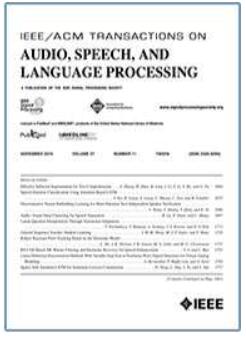Smoothed Frame-Level SINR and Its Estimation for Sensor Selection in Distributed Acoustic Sensor Networks
IF 5.1
2区 计算机科学
Q1 ACOUSTICS
IEEE/ACM Transactions on Audio, Speech, and Language Processing
Pub Date : 2024-10-09
DOI:10.1109/TASLP.2024.3477277
引用次数: 0
Abstract
Distributed acoustic sensor network (DASN) refers to a sound acquisition system that consists of a collection of microphones randomly distributed across a wide acoustic area. Theory and methods for DASN are gaining increasing attention as the associated technologies can be used in a broad range of applications to solve challenging problems. However, unlike traditional microphone arrays or centralized systems, properly exploiting the redundancy among different channels in DASN is facing many challenges including but not limited to variations in pre-amplification gains, clocks, sensors' response, and signal-to-interference-plus-noise ratios (SINRs). Selecting appropriate sensors relevant to the task at hand is therefore crucial in DASN. In this work, we propose a speaker-dependent smoothed frame-level SINR estimation method for sensor selection in multi-speaker scenarios, specifically addressing source movement within DASN. Additionally, we devise an approach for similarity measurement to generate dynamic speaker embeddings resilient to variations in reference speech levels. Furthermore, we introduce a novel loss function that integrates classification and ordinal regression within a unified framework. Extensive simulations are performed and the results demonstrate the efficacy of the proposed method in accurately estimating smoothed frame-level SINR dynamically, yielding state-of-the-art performance.分布式声学传感器网络中用于传感器选择的平滑帧级 SINR 及其估算
分布式声学传感器网络(DASN)是指一种声音采集系统,由随机分布在广阔声学区域的传声器组成。由于相关技术可广泛应用于解决各种挑战性问题,DASN 的理论和方法日益受到关注。然而,与传统的麦克风阵列或集中式系统不同,在 DASN 中正确利用不同信道之间的冗余面临着许多挑战,包括但不限于前置放大增益、时钟、传感器响应和信号干扰加噪声比 (SINR) 的变化。因此,选择与当前任务相关的适当传感器对于 DASN 至关重要。在这项工作中,我们提出了一种依赖于扬声器的平滑帧级 SINR 估算方法,用于在多扬声器场景中选择传感器,特别是解决 DASN 中的信号源移动问题。此外,我们还设计了一种相似性测量方法,用于生成动态扬声器嵌入,以适应参考语音电平的变化。此外,我们还引入了一种新的损失函数,将分类和顺序回归整合到一个统一的框架中。我们进行了广泛的模拟,结果表明所提出的方法在动态准确估计平滑帧级 SINR 方面非常有效,达到了最先进的性能。
本文章由计算机程序翻译,如有差异,请以英文原文为准。
求助全文
约1分钟内获得全文
求助全文
来源期刊

IEEE/ACM Transactions on Audio, Speech, and Language Processing
ACOUSTICS-ENGINEERING, ELECTRICAL & ELECTRONIC
CiteScore
11.30
自引率
11.10%
发文量
217
期刊介绍:
The IEEE/ACM Transactions on Audio, Speech, and Language Processing covers audio, speech and language processing and the sciences that support them. In audio processing: transducers, room acoustics, active sound control, human audition, analysis/synthesis/coding of music, and consumer audio. In speech processing: areas such as speech analysis, synthesis, coding, speech and speaker recognition, speech production and perception, and speech enhancement. In language processing: speech and text analysis, understanding, generation, dialog management, translation, summarization, question answering and document indexing and retrieval, as well as general language modeling.
 求助内容:
求助内容: 应助结果提醒方式:
应助结果提醒方式:


